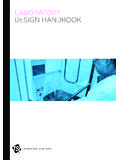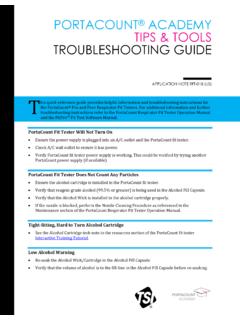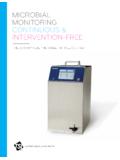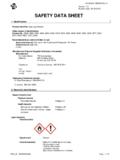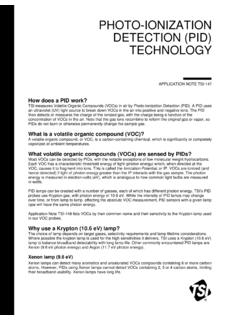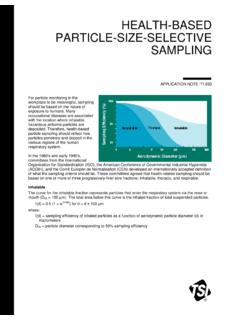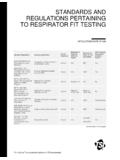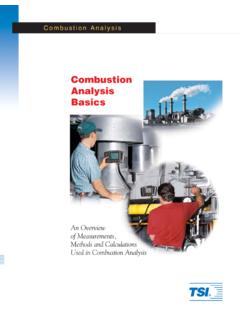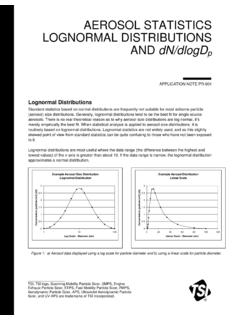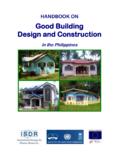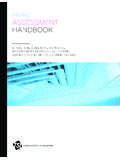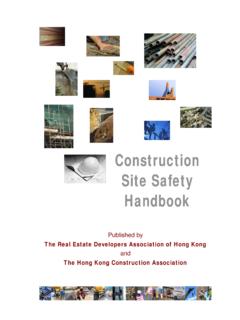Transcription of IAQ Handbook 2011 US 2980187-web - TSI, Inc
1 _____ TSI, TSI logo, Alnor, VelcoiCalc and AccuBalance are registered trademarks of TSI Incorporated. IAQ-Calc, DP-Calc, TrakPro, LogDat2, and Airflow Instruments are trademarks of TSI Incorporated. Copyright 2013 by TSI Incorporated indoor AIR quality Handbook A PRACTICAL GUIDE TO indoor AIR quality INVESTIGATIONS indoor Air quality Handbook _____ TSI, TSI logo, Alnor, VelcoiCalc and AccuBalance are registered trademarks of TSI Incorporated. IAQ-Calc, DP-Calc, TrakPro, LogDat2, and Airflow Instruments are trademarks of TSI Incorporated. Copyright 2013 by TSI Incorporated Contents Introduction .. 1 building design and Operation .. 3 Effects of Poor quality Air .. 3 Types of Pollutants .. 4 Controlling Sources of Pollutants.
2 4 Investigating indoor Air quality .. 5 Measurements Used to Determine Air quality .. 6 Comfort Issues and Productivity .. 6 What to Measure Temperature .. 7 What to Measure Humidity .. 7 What to Measure Air Movement and Flow The three V s Velocity, Volume and Ventilation .. 8 Health and Safety Issues .. 11 What to Measure Carbon Monoxide .. 11 What to Measure Airborne Particles .. 12 What to Measure Ultrafine Particles .. 13 What to Measure Bioaerosols .. 14 What to Measure Chemicals in Aerosol Form (Condensates) .. 15 What to Measure Light, Noise, Vibration, Ergonomics, Odors, etc.. 16 Conclusion .. 16 Sources for Information Relating to indoor Air quality Evaluations .. 17 Standards and Guidelines .. 18 IAQ Instruments from TSI.
3 19 indoor Air quality Handbook NOTES _____ _____ _____ _____ _____ _____ _____ _____ _____ _____ _____ _____ _____ _____ _____ _____ _____ _____ _____ _____ _____ _____ _____ _____ _____ _____ _____ _____ _____ indoor Air quality Handbook indoor Air quality Handbook 1 INTRODUCTION Concern about indoor air quality (IAQ) and the study of air quality issues is a fairly recent phenomenon. Some of the earliest documented studies occurred in Scandinavia in the mid-1960s and were focused primarily on thermal comfort issues. For the first decade or so, IAQ studies primarily involved comparing indoor air to outdoor air. The level of outdoor pollution was a chief concern and the goal was to ensure that indoor air was of better quality than the outdoor air subjected to pollutants.
4 As studies increased in sophistication, other measurable factors came into play. building construction materials and techniques changed radically. A reduction in natural ventilation, or "fresh" air, in the interest of saving energy became a concern and, finally, people realized that pollutants could actually originate within a building . The World Health Organization (WHO) estimated that more than 30 percent of all commercial buildings have significant IAQ problems. For many years, people working in areas with known exposure to potential hazards have had a number of options available with respect to personal protection, including equipment such as respirators, hard hats, gloves, goggles, and more. indoor air quality as discussed here, however, applies to areas or situations where people are generally unaware of potential hazards.
5 They normally do not expect to need protection and this is why the subject has become so important. Since the energy crisis of the 1970s, buildings have been constructed much tighter, significantly lowering the exchange of indoor and outdoor air. The strategy has been to save energy costs by re-circulating internal air and minimizing the need to heat, cool or condition outdoor air. Although considerable savings are realized with this strategy, unwanted contaminants can and do become trapped in these tight enclosures. In some cases, the quality of indoor air can be Air quality Handbook 2 TSI Incorporated Recent developments in construction materials have resulted in the use of more synthetics and composites, which can affect air quality .
6 Radical changes in technology have led to innovations such as computers and photocopiers that provide greater efficiencies and time savings, but they can also affect the quality of indoor air. These potentially adverse effects are further complicated by the fact that people are spending more time than ever indoors, up to 90 percent according to estimates by the Environmental Protection Agency (EPA). It is easy to understand why there is a growing concern about the quality of the air we breathe. People are spending more than 90 percent of their time indoors. As a result of these and other factors, totally new terminology has come into use and the topic is gaining more attention every day. Some examples include: Sick building Syndrome (SBS) where more than 30 percent of occupants experience adverse effects while in the building , but no clinically diagnosed disease is found.
7 building Related Illness (BRI) general term for a medically diagnosable illness caused by, or related to, building occupancy. Multiple Chemical Sensitivity (MCS) or Environmental Illness (EI) a controversial condition where an individual has or develops sensitivity to even low levels of certain chemicals due to extended exposure. Bottom line, the quality of indoor air can and does impact productivity, personal comfort, building maintenance costs and even health and safety, either positively or negatively depending on how air quality is managed. indoor Air quality Handbook indoor Air quality Handbook 3 building design and Operation Ensuring satisfactory air quality requires a good understanding of the building itself.
8 The design , physical layout, mechanical systems, equipment and space usage are all essential elements that can affect air quality . The air distribution system requires particular attention. How does outdoor air get in? Is the air filtered? How does air circulate throughout the building ? Understand how spaces are designed and where walls, furnishings and equipment are located. Keep in mind the building layout can create physical barriers that impede the flow and distribution of air, which can impact the quality of air in a given area. Unwanted contaminants move from areasof relative positive pressure to those of relative negativepressure through a path of least resistance. Consider pollutant "pathways" which allow airborne gases and particles to migrate to different areas of the building .
9 These pathways may not be obvious and are not necessarily physically defined. Pollutants can travel by air movement or pressure differential where unwanted contaminants move from areas of relative positive pressure to those of relative negative pressure through a path of least resistance. Effects of Poor quality Air In this Handbook , when we talk about factors affecting air quality , we are beyond the already proven hazardous materials where exposure limits have been set and personal protective equipment prescribed. Here, we address what would be considered "normal" air in offices, schools, libraries, churches, hospitals and other interior spaces where we spend time without expecting to face any risks. Different people react differently todifferent levels of different substances.
10 As bizarre as it sounds, there is no universal reaction to a measured amount of a particular material. People simply have different tolerance levels. It is difficult to assign standards or even guidelines to set acceptable versus unacceptable levels of literally thousands of airborne pollutants. Many indoor air contaminants are actually new, bred from the ever-changing technology that so many of us are exposed to daily. From alternative energy sources to photocopiers, we are generating new pollutants at an ever-increasing pace. indoor Air quality Handbook 4 TSI Incorporated Typical symptoms caused by air quality problems vary greatly according to an individual's sensitivity and may include chills, sweating, eye irritation, allergies, coughing, sneezing, nausea, fatigue, skin irritation, breathing difficulty and others.
